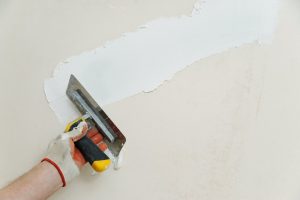TYPES AND FEATURES OF PUTTY FOR INTERNAL WORKS
 To level the walls and prepare them for final finishing, putty is used. Surface treatment with this building material is one of the important stages of repair work. The final result largely depends on the individual properties and quality indicators of each mixture.
To level the walls and prepare them for final finishing, putty is used. Surface treatment with this building material is one of the important stages of repair work. The final result largely depends on the individual properties and quality indicators of each mixture.
Putting starting putty
Kinds
Putty varies in grain size, which determines the purpose and the spraying solution.
Starting – coarse-grained, poorly amenable to polishing, the surface is rough. It is used to fill cracks, leveling brick and concrete walls under thick wallpaper, panels. Dries very quickly, does not crack;
Finishing – often fine grinding. It is used at the final stage of repair, when preparing the foundation for the final finish. Lay down a smooth layer with a slight shrinkage. It is well polished, but at the same time a lot of dust is formed. Less durable than starting;
Universal – combines the characteristics of the previous versions, which makes it possible to use it at various stages of repair. Eliminates minor irregularities, lays down evenly, does not need further processing.
Putty is available in two aggregative states – dry and ready. The first involves adding water before starting work and dries quickly. It requires careful storage, as it is packed in cardboard bags. The second type of mixture is poured into plastic buckets and can be used immediately after opening, has a long shelf life.
Putting finishing putty
Composition Options
On the market there are many types of putty with various practical indicators. From the inclusion of certain elements depend on the functional features of the solution.
Cement – in addition to the main component consists of sand and solvent. There are several grades of strength. Not afraid of moisture;
Gypsum – for finishing – is not subject to shrinkage, has great plasticity, smoothness. Dries quickly. Fire resistant;
Polymer – different elasticity, durability of the coating, water resistance. It is allocated with extensive scope of application. Sometimes acrylic and latex.
Surface puttying
The nuances of choice
When buying solutions are selected from one manufacturer. It is better not to mix products from different companies – this can negatively affect the result;
Carefully read the manufacturers’ recommendations regarding the method and environment of using one or another type of putty;
For finishing finishing under the paint it is better to give preference to ready-made mixtures, and under the wallpaper – dry;
Pay attention to the homogeneity of the structure, there should not be large inclusions;
When it is difficult to make a choice – it is worthwhile to dwell on a universal composition.
Putty walls
Application technology
The putty is laid on the prepared, dust-free and primed surface. The dry mixture is mixed with the liquid and thoroughly mixed;
The applied layer should be no more than 1.5 mm thick;
The number of layers depends on the initial condition of the walls and the type of subsequent finishing;
The spatula is always kept clean and cleaned regularly;
Minor bugs are fixed by grinding.
Putty is one of the building materials, which is mandatory used in the repair and decoration of walls. Starting and finishing options allow you to create a durable, smooth and even coating suitable for pasting wallpaper, installing wall panels and applying paint.



